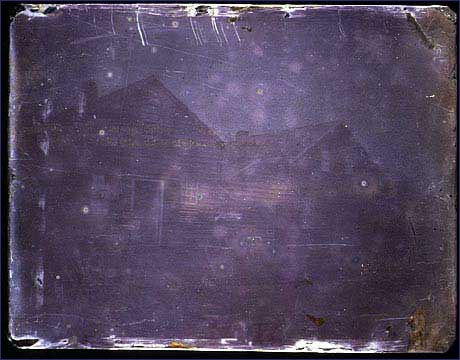唔一定要黑白相至懷舊, 彩色相 (真正彩色, 唔係人手上色) 已經超過 160 年歷史, 第一代彩色相 (早至 1850 年):
http://en.wikipedia.org/wiki/Levi_Hill

A
Hillotype from c. 1850

A circa 1850 "Hillotype" photograph of a colored engraving. Long believed to be a complete fraud, recent testing found that
Levi Hill's process did reproduce some color photographically, but also that many specimens had been "sweetened" by the addition of hand-applied colors.


 Levi Hill (born 1816) was an American minister in Upstate New York who claimed to have invented the first color photographic process in 1850. Hill called his process "Heliochromy", though the plates created became commonly referred to as "Hillotypes". Though his work was met with skepticism during his lifetime, subsequent researches have tended to show that his process did in fact have a crude ability to reproduce colors in the natural world.
Life and work
Hill was a Baptist minister in Westkill (Greene County) in the New York Catskill Mountains area. Though many were of the opinion that the color in his photographs was added by hand-dyeing, he received support from some in the scientific community, particularly Samuel F. B. Morse, inventor of the telegraph. He wrote a A Treatise on Heliochromy describing his process in 1851.
Subsequent research
A chemical analysis of Hill's work by researchers affiliated with the Smithsonian's National Museum of American History[1] conducted in 2007 found that dyes had indeed been used to enhance the color in the Hillotypes, but that these accounted for only a portion of the photographs' color. They found that reds and blues had been genuinely (if crudely) reproduced, and that other colors been added fraudulently.[2] Getty Conservation Institute senior scientist Dusan Stulik, who performed the analysis of the daguerreotypes with colleague Art Kaplan discovered that, “After pressure mounted to produce additional colors...Hill began adding additional pigments to his color plates by hand, doctoring them to look more multi-hued than the originals." [3]
Photography professor and historian Joseph Boudreau compounded the archaic chemistry and replicated the techniques described by Hill in A Treatise on Heliochromy in 1981, and was able to recreate Hillotype plates in distinct, verifiable, muted colors, including red, green, blue, yellow, magenta, and orange; these colors were all produced by the action of light alone, without the application of dyes or pigments.[4]
External links
Levi Hill (born 1816) was an American minister in Upstate New York who claimed to have invented the first color photographic process in 1850. Hill called his process "Heliochromy", though the plates created became commonly referred to as "Hillotypes". Though his work was met with skepticism during his lifetime, subsequent researches have tended to show that his process did in fact have a crude ability to reproduce colors in the natural world.
Life and work
Hill was a Baptist minister in Westkill (Greene County) in the New York Catskill Mountains area. Though many were of the opinion that the color in his photographs was added by hand-dyeing, he received support from some in the scientific community, particularly Samuel F. B. Morse, inventor of the telegraph. He wrote a A Treatise on Heliochromy describing his process in 1851.
Subsequent research
A chemical analysis of Hill's work by researchers affiliated with the Smithsonian's National Museum of American History[1] conducted in 2007 found that dyes had indeed been used to enhance the color in the Hillotypes, but that these accounted for only a portion of the photographs' color. They found that reds and blues had been genuinely (if crudely) reproduced, and that other colors been added fraudulently.[2] Getty Conservation Institute senior scientist Dusan Stulik, who performed the analysis of the daguerreotypes with colleague Art Kaplan discovered that, “After pressure mounted to produce additional colors...Hill began adding additional pigments to his color plates by hand, doctoring them to look more multi-hued than the originals." [3]
Photography professor and historian Joseph Boudreau compounded the archaic chemistry and replicated the techniques described by Hill in A Treatise on Heliochromy in 1981, and was able to recreate Hillotype plates in distinct, verifiable, muted colors, including red, green, blue, yellow, magenta, and orange; these colors were all produced by the action of light alone, without the application of dyes or pigments.[4]
External links